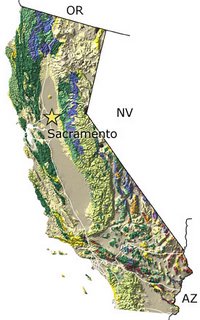 First, I'll need a series of maps from the paleotonlogy portal through time of the BCGW. I'll let you figure out what that is.
First, I'll need a series of maps from the paleotonlogy portal through time of the BCGW. I'll let you figure out what that is.To get you started, here is picture of California, the Interstates are in white. Look for the I-40, because it is the northern boundary of the BCGWA. The colors represent rocks on the surface from various geologic eras. Couldn't seem to upload the legend, but I will include each map as I go through time. Fasten your seatbelts, this will be a long ride.
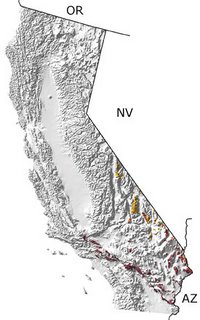 "Precambrian rocks in California include igneous and metamorphic basement rocks, as well as some sedimentary rocks (limestone, dolostone, and sandstones, which have often been altered to quartzite). These sedimentary rocks can be found in the White Mountains, Inyo Mountains, and around Death Valley. Most of these rocks do not contain fossils, although some traces and a few fossils have been found in the younger geologic formations of Precambrian age."
"Precambrian rocks in California include igneous and metamorphic basement rocks, as well as some sedimentary rocks (limestone, dolostone, and sandstones, which have often been altered to quartzite). These sedimentary rocks can be found in the White Mountains, Inyo Mountains, and around Death Valley. Most of these rocks do not contain fossils, although some traces and a few fossils have been found in the younger geologic formations of Precambrian age."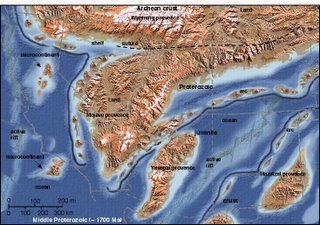
"The interpretation of the earliest geologic history of Southwestern North America is very speculative. At approximately 1.7 Ga (1700 Ma), the region probably resembled modern SE Asia. As various tectonic blocks collided, orogenic (mountain-building) events were generated. This view shows what the region may have looked like during these collisional events."
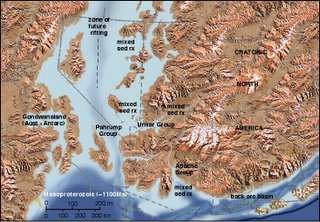
"About 1.1 Ga North America was part of the supercontinent Rodinia. The Southwest possibly lay adjacent to Australia and/or Antarctica or possibly Siberia. An arc complex lay off southern North America. Various sedimentary rocks were formed near the margins of North America."
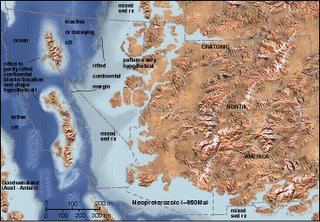
"The western margin of North America (NAM) was originally formed during the late Proterozoic (Precambrian), about 650 million years ago, during a major rifting event in which North America separated from the supercontinent Rodinia. The map shows the hypothetical pattern of rifting and the resulting patterns of late Proterozoic siliciclastic sedimentation. The rifted, attenuated (thinned and stretched) margin subsided and was the site of thick sequences of sandstone, mudstone, and limestone. The Cordilleran passive margin was born."
Sorry, the outlines of the states are not so good. I have re-done my printed copies, so it is easier to see. Well, it was soooooo long ago, does it really matter? Tee hee.
Next up the Cambian.
I need to get someone to orient me to these maps. I want to be sure where the Sacramento Mountains are. Then the rest will fall into place. I will do the same with the Arizona maps, but we are concentration on the BCGW now. Just to let you know again, probably, I am going through the alphabetic list of the wilderness areas at the BLM site.
Let's look at some rocks, not minerals, but the host rock in the area. Remember this also includes the area across the freeway from the wilderness area.
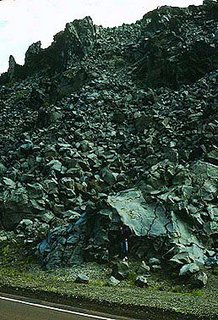 Rhodacite
Rhodacite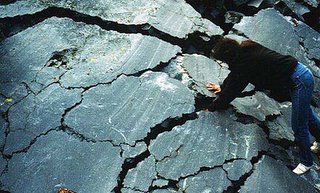
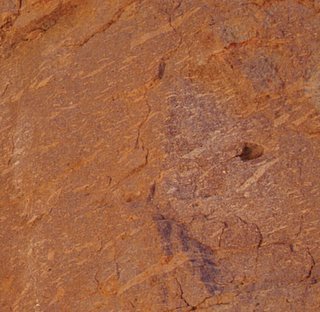 Tuff
Tuff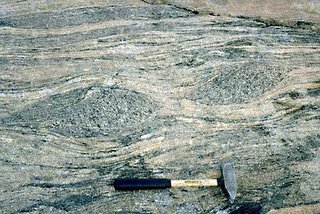 Granitoid
Granitoid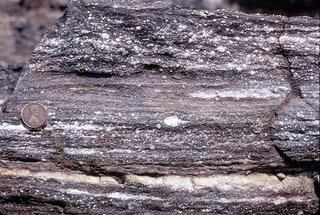 Mylonite
MyloniteNot much luck finding photos. I'll use this one.
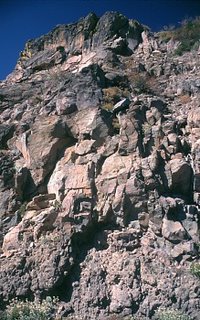 Andesite
Andesite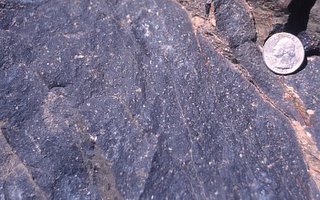
Gaby and I are going out tomorrow and walk around and take pictures of outcroppings and take samples. Hmmmmm? I wonder what we will find?
Then, I will need some photos of minerals found in the area from the mineral site. I'll just post the photos from USA/Arizona, California, Nevada.
There were 50 "nearest localities" within an approximate 9 mile radius of "old" Bannock and Bertha. Most of them were gold, silver, and copper minds or prospect. Chuckwalla Wash Prospect had the most other minerals listed, so I will use that list to learn about other minerals that might be found in the area. Be aware of the link below to the Chuckwalla Wash Prospect.
Our old friend Barite (Baryte):
See post below.
Bornite: (This is fun!)
Chemistry: Cu5FeS4, Copper Iron Sulfide
Class: Sulfides
Uses: Major ore of copper and as mineral specimens.
Specimens
Bornite is an important copper ore mineral. It ranks up there with many of the other copper ores such as chalcocite, chalcopyrite, covellite, digenite, cuprite and tetrahedrite. As a mineral specimen, bornite is usually lacking [sic]. Good crystals are rare and thus bornite is commonly known as simply a massive mineral ore.
It does however get used in the mineral trade as a curiosity called "peacock ore". A favorite among children, the bornite chunks sold as peacock ore or alternatively peacock copper have a rich bouquet of colors. The colors are from an iridescent tarnish that forms on bornite upon exposure to air. The tarnish is made of assorted copper oxides or hydroxides that form a mere atoms thin layer over the bornite. The thickness of the layers is close to the wavelength of light. When light waves bounce between the bornite surface and the top of the tarnish layer they will leave with the wavelengths of various colors. This effect is the same as the rainbow effect that occurs with oil on water. In the case of bornite, the tarnish will have a purplish, violet or blue color. Because bornite is often intergrown with chalcopyrite which tarnishes to more greens and yellows, the peacock ore may have many colors ranging from purple to blue to green to yellow.
Bornite's crystals, if found, are usually distorted cubes with curved faces. Even rarer are the distorted octahedrons and dodecahedrons. These are isometric crystals. However, bornite's structure at normal temperatures is not isometric. Bornite is only isometric at temperatures above 228 degrees celsius and it was above this temperature that the crystals formed. As bornite cooled it structurally altered to possibly a tetragonal structure but outwardly it retained the isometric forms.
http://mineral.galleries.com/minerals/sulfides/bornite/bornite.htm
These photos are from mindat.org. The one on the bottom is from Arizona.

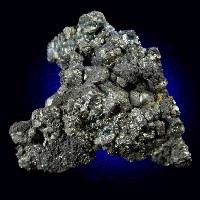
Here is a link to the Chuckwalla Gold Mine. We are going to have to tread very carefully there!
http://www.gwmg.ca/properties/chuckwalla.php

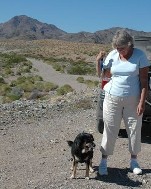




No comments:
Post a Comment